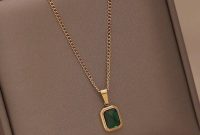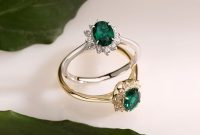Emerald Buying Guide: Tips to Choose the Perfect Gem
 Emeralds have captivated civilizations for thousands of years, revered for their lush green color and rich symbolism. As one of the “big four” precious gemstones, along with diamond, sapphire, and ruby, emeralds hold a special place in the world of fine jewelry and gemology. However, buying an emerald isn’t as straightforward as choosing the one with the deepest color or the largest carat size. From clarity to cut, origin to treatment, there are many factors that influence the beauty, durability, and value of an emerald. This guide is designed to walk you through every important consideration so you can make an informed and confident purchase.
Emeralds have captivated civilizations for thousands of years, revered for their lush green color and rich symbolism. As one of the “big four” precious gemstones, along with diamond, sapphire, and ruby, emeralds hold a special place in the world of fine jewelry and gemology. However, buying an emerald isn’t as straightforward as choosing the one with the deepest color or the largest carat size. From clarity to cut, origin to treatment, there are many factors that influence the beauty, durability, and value of an emerald. This guide is designed to walk you through every important consideration so you can make an informed and confident purchase.
The Importance of Color in Emerald Selection Color is the most important characteristic when evaluating emeralds. Unlike diamonds, which prioritize clarity, emeralds are loved for their vibrant green hues. The ideal emerald color is a deep, rich green with a slight bluish undertone. It should not be too dark or too light. Too dark, and the gem loses its brightness; too light, and it resembles a green beryl rather than a true emerald.
Three primary components determine an emerald’s color: hue, tone, and saturation. Hue refers to the basic color (in this case, green), while tone measures the darkness or lightness. Saturation refers to the purity and intensity of the green color. The most prized emeralds exhibit a vivid green hue with medium to medium-dark tone and strong saturation. Stones with brown or yellow secondary hues are considered less desirable and are often more affordable.
Color consistency across the gem is also essential. Uneven color distribution can make a gem appear less vibrant and can lower its value. When choosing an emerald, it’s best to view the stone under natural light, as artificial lighting can distort its true color.
Clarity: Embracing the Imperfections Unlike diamonds, emeralds typically contain inclusions. These internal characteristics, often referred to as “jardin” (French for garden), are part of what makes emeralds unique. While clarity is still important, it is not expected for emeralds to be flawless. In fact, if you find a completely clear emerald, it may be synthetic or heavily treated.
However, the type, size, and placement of inclusions can significantly impact both the beauty and structural integrity of the gem. Large, dark, or surface-reaching inclusions may weaken the stone and reduce its brilliance. The best emeralds have inclusions that are not easily visible to the naked eye or that are artfully hidden by the cutter to maximize visual appeal.
Eye-clean emeralds—those that appear clean when viewed with the naked eye—are rare and command high prices. Most emeralds on the market have visible inclusions, and that’s perfectly acceptable as long as they do not affect durability or dramatically reduce the stone’s transparency. Clarity is often a matter of personal preference, but it’s essential to examine each stone closely and ask for magnified views when buying online.
The Role of Cut in an Emerald’s Appearance The cut of an emerald plays a critical role in how the gem interacts with light and how its color is perceived. Because emeralds are softer and more brittle than many other gemstones, they require careful cutting to minimize the risk of breakage. The traditional emerald cut, a rectangular step cut with beveled corners, was designed specifically for this purpose. It protects the gem from chipping while also highlighting its color and minimizing the visibility of inclusions.
While the emerald cut remains the most popular, other cuts like oval, pear, and round are also available. These shapes can enhance brilliance and are often used to create more unique or contemporary designs. However, fancy cuts may waste more material during the cutting process, making the finished gemstone more expensive per carat.
Symmetry, proportions, and polish are all important aspects of the cut. A well-cut emerald will display even color, good brilliance, and a balanced appearance. Poor cutting can result in dullness, dark areas, or awkward outlines. It’s worth investing in a well-cut stone, as it can make a significant difference in overall visual impact.
Carat Weight and Its Impact on Price Carat weight is another major factor in the price of emeralds, but it doesn’t always correlate directly with visual size. Because emeralds have a lower density than diamonds, a one-carat emerald will appear larger than a one-carat diamond. However, as carat weight increases, the price per carat tends to rise exponentially—especially for high-quality stones with good color and clarity.
Large emeralds of fine quality are rare and highly valuable. For budget-conscious buyers, it’s often wiser to choose a smaller emerald with superior color and clarity rather than a larger stone with visible flaws or pale color. Because color is the top priority for emeralds, you may find that a smaller but vividly colored gem is more visually appealing than a larger, duller one.
It’s also important to consider how the stone will be set. A well-designed setting can enhance the perceived size and brilliance of a smaller emerald, offering better overall aesthetics and value.
Natural vs. Treated Emeralds Nearly all emeralds on the market today are treated in some way to enhance their appearance. The most common treatment is oiling—filling surface-reaching fractures with colorless oil (often cedarwood oil) to reduce their visibility and improve clarity. This is a widely accepted and traditional practice, but it must be disclosed to the buyer.
Other treatments may involve the use of synthetic oils, resins, or polymers. These non-traditional substances can make the stone appear clearer but are considered less desirable and can affect the stone’s long-term durability. Over time, these fillers may degrade, requiring the emerald to be re-oiled to maintain its appearance.
Always ask for treatment disclosure and documentation when buying an emerald. Reputable sellers will clearly state whether the stone has been treated, what type of treatment was used, and to what extent. Untreated emeralds with good clarity are extremely rare and command premium prices.
Country of Origin and Its Influence The origin of an emerald can significantly impact its value and desirability. Colombia is the most famous source of high-quality emeralds, known for their deep green color and exceptional clarity. Colombian emeralds, particularly those from the Muzo, Chivor, and Coscuez mines, are often considered the gold standard.
Zambian emeralds have also gained popularity in recent years. These stones tend to be darker with a bluish-green hue and are often cleaner than Colombian emeralds due to fewer inclusions. While not traditionally as expensive as Colombian stones, high-quality Zambian emeralds can be just as beautiful and are sometimes more affordable.
Other sources include Brazil, Afghanistan, and Ethiopia. Brazilian emeralds often have a lighter green color and are more likely to be found in larger sizes. Ethiopian emeralds are a relatively new entrant to the market and vary widely in quality.
The country of origin can affect pricing and prestige, but it should not be the sole factor in your decision. Focus more on the individual stone’s characteristics than its geographical provenance.
Certification and Authenticity Due to the high value and frequency of treatments, certification is crucial when purchasing an emerald. A certified gem comes with a lab report verifying its authenticity, natural origin, and treatment status. Trusted gemological laboratories include GIA (Gemological Institute of America), AGL (American Gemological Laboratories), and IGI (International Gemological Institute), among others.
Certificates provide peace of mind and ensure you are not overpaying for a synthetic or heavily treated stone. They are especially important for high-value purchases or investment-grade gems. Always ensure that the lab report matches the exact stone you are buying, including its weight, dimensions, and identifying features.
Be cautious of vendors who cannot provide reliable documentation or who offer vague details about the stone’s origin or treatments. A certified emerald, though potentially more expensive, is a safer and smarter long-term investment.
Choosing the Right Setting The setting plays a vital role in both the appearance and durability of your emerald. Because emeralds are relatively soft and brittle (ranking 7.5–8 on the Mohs scale), they must be protected from impact and pressure. Prong settings, while classic, should be designed to shield the corners and edges of the emerald. Bezel settings offer greater protection by surrounding the stone with metal, making them ideal for rings and daily wear.
The metal you choose for the setting can also enhance the gem’s color. Yellow gold often enriches warm green tones, while white metals like platinum or white gold can create a modern contrast. Rose gold provides a romantic and vintage appeal, complementing bluish-green emeralds especially well.
Consider how the setting design interacts with the stone’s characteristics. A busy or ornate setting may distract from a beautiful gem, while a minimal design can allow the emerald’s color and brilliance to shine.
Budgeting Wisely for Your Emerald Purchase Setting a realistic budget is key when buying an emerald. Prices can vary widely depending on size, quality, origin, and treatment status. A modest budget can still secure a beautiful stone if you prioritize color and are flexible on clarity or size. Conversely, if you are investing in a high-grade emerald, it’s worth allocating more for certification, custom settings, and long-term care.
Remember to account for additional costs such as taxes, insurance, and maintenance. Emeralds require more care than harder gems like diamonds, so regular cleaning and occasional oiling might be necessary over the years.
Buying from a trusted dealer—whether online or in-store—is essential. Look for vendors with transparent policies, good return options, and detailed product information. Taking time to educate yourself before purchasing will lead to greater satisfaction and fewer regrets.
Final Thoughts Emeralds are timeless gems that carry an unmatched elegance and mystique. Whether you’re drawn to their lush green color, symbolic meanings, or astrological properties, owning an emerald is both a personal and financial investment. By understanding the core principles of color, clarity, cut, carat weight, treatments, and origin, you can navigate the emerald market with confidence and clarity.
A well-chosen emerald is more than just a beautiful piece of jewelry—it’s a treasure of the Earth, steeped in history, passion, and energy. With careful consideration and a bit of guidance, you’ll be able to find the perfect emerald that suits your taste, aligns with your values, and stands the test of time.




